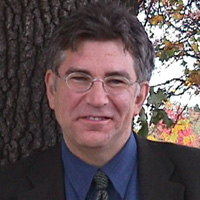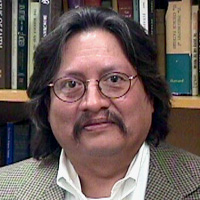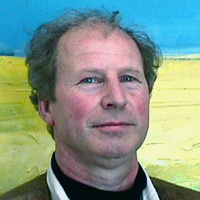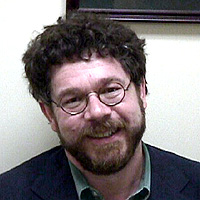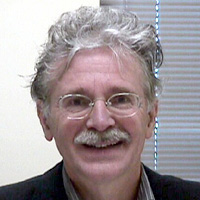|
|
Edward S. Casey (SUNY Stony Brook), December 3, 2001 Between Geography and Philosophy: What does iIt Mean to Inhabit the Place-World? Geographers and philosophers have been converging for some time now - especially in the area of "cultural geography," whose pioneering figures include Yi-Fu Tuan, Edward Relph, Nicholas Entrikin, Edward Soja, and others. While geographers have been turning to philosophy for inspiration, few philosophers have directed themselves to geography. Casey tries to rectify this imbalance by suggesting how philosophical notions of the self and body and place should have direct relevance to geographical theory while drawing inspiration from this theory itself. |
|
Dennis J. Schmidt (Villanova University), November 27, 2001 "Like a fire that consumes all before it...." It is clear that words and images each belong to the deepest forms of thinking, but it is not clear that they shape what can be thought in the same way. Since Plato, there has been a deep distrust of the presence of images in thinking. In the Republic, he even argues that we do not think if we relate only to images. The influence of this argument can be seen in the philosophical mistrust that is expressed with regard to the achievements of art. But beginning with Kant and Nietzsche, we find the formulation of the claim that works of art might offer possibilities for thinking that are found in no other medium, culminating in the views of such thinkers as Merleau-Ponty, Heidegger, Gadamer, and Derrida. Schmidt explores this issue by looking at the way in which the painter Cy Twombly has painted a series of images entitled "Fifty Days at Ilium" which are themselves commentaries on the respective possibilities of the word and of the image. Schmidt is Professor of Philosophy at Villanova University. For many years prior to moving to Villanova, he was Professor of Philosophy and Comparative Literature at Binghamton University where he was the Director of the Program in Philosophy, Interpretation and Culture. He has also taught at the University of Tuebingen in Germany. He is the author of Lyrical and Ethical Subjects: Essays on the Periphery of the Word, Freedom, and History (SUNY Press); On Germans and Other Greeks: Tragedy and Ethical Life (Indiana University Press); The Ubiquity of the Finite: Hegel: Heidegger and the Entitlements of Philosophy (MIT Press). Translator of Ernst Bloch's Natural Law and Human Dignity (MIT Press). He is the coeditor of Hermeneutische Wege: Hans-Georg Gadamer zum Hundertsten Geburtstag (Siebeck Verlag), and the editor of the SUNY Press "Series in Continental Philosophy." The book he is currently writing is on the history of the idea of nature in Western culture. |
|
|
|
Rick Turner (The Nature Conservancy of Texas), November 14, 2001, EESAT 130, 7:30pm-9:00 pm Setting Priorities through Ecoregional Conservation Planning From majestic longleaf pine forests to bald cypress swamps, from the endangered red cockaded woodpecker - the only woodpecker that constructs its nest in living pine trees - to insect-eating plants, the West Gulf Coastal Plain of eastern Texas and western Louisiana harbors a wealth of biological diversity. This presentation provides an overview of an ecoregional conservation plan developed by The Nature Conservancy to ensure the long-term survival of the species, natural communities, and ecosystems of the West Gulf Coastal Plain. Turner is Conservation Ecologist for The Nature Conservancy's East Texas Program and the Texas Conservation Data Center. A native Texan, Rick received his Bachelor of Science in Forestry and Master of Science in Biology at Stephen F. Austin State University in Nacogdoches, Texas. His professional interests include community and landscape ecology, conservation biology, and ecological restoration. His accomplishments include developing an ecological classification system for over one million acres of national forest land in Texas and Louisiana, and leading the effort to create The Nature Conservancy's West Gulf Coastal Plain coregional conservation plan. Rick also serves as planning team member for the Mississippi Alluvial Valley Joint Venture - West Gulf Coastal Plain Bird Conservation Initiative, and as advisory board memberfor the Pineywoods Native Plant Center in Nacogdoches. |
|
Steve Whisenant (Department of Rangeland Ecology and Management, Texas A&M University), October 31, 2001, EESAT 130, 7:30pm-9:30pm Ecological Restoration in the Real World Whisenant will discuss ecological projects in the US, China, Niger, and Poland as examples to illustrate two main points: (1) Narrow definitions of restoration (purist approach) are often out of touch with our current ecological understanding and with socioeconomic conditions in much of the world. Ecological restoration presents powerful tools for repairing damaged ecosystems. (2) It is important to focus on restoring function rather than structure to damaged ecosystems. That may involve returning structural components, but the focus should be on function. |
|
|
|
Christopher Preston (Department of Philosophy, University of South Carolina), October 16, 2001, EESAT125, 7:30 pm-9:00 pm The Necessity of Narrative in Environmental Ethics? One of the most provocative pieces of writing in the environmental ethics literature is a first person narrative about scaling a rock face written by Karen Warren. Warren shows how her narrative exibits many important feminist ethical sensibilities. I want to broaden Warren's claim and suggest that narratives are also central to other kinds of environmental ethics. A careful look at one of the most popular non-narrative approaches to environmental ethics, the claim that nature has objective intrinsic value, reveals that narrative lies at its heart. This claim raises some interesting questions about the connection between the evolutionary and ecological tradition and environmental ethics. Christopher Preston is an assistant professor of philosophy at the University of South Carolina teaching classes in philosophy, the school of the environment, and in women's studies. He is a native of England and has a bachelors degree from the University of Durham in England, a masters degree from Colorado State University, and a Ph.D. from the University of Oregon. In the past, he has fished commercially and worked for the National Park Service in Alaska. |
|
Jaime Armin Mejía (Department of English, Southwest Texas State University, San Marcos), April 27, 2001, EESAT 320A, 2:00pm-3:30pm From Philosophy to Mexican-American Literature Jaime Mejía received B.A.'s in philosophy and political science from the University of North Texas in 1978, with minors in English, history, and Spanish. He received an M.A. in English from Pan American University in Edinburg, Texas in 1985 with concentrations in rhetoric and composition, nineteenth and twentieth century American literature, and Mexican-American literature. In 1993 he earned a Ph.D. in English from Ohio State University, with concentrations in rhetoric and composition, twentieth-century British and American modern literature, and Mexican-American literature. He wrote his dissertation on "Transformations in Rolando Hinojosa's Klail City Death Trip Series." Since 1993 he has been an assistant professor in the Department of English at Southwestern Texas State University in San Marcos, Texas. |
|
|
|
Chris Drury (Land Artist, Lewes, East Sussex), April 23, 2001, EESAT 125, 3:00 pm-4:30 pm Chris Drury is categorized as a land artist or someone who works with art and nature. His work explores nature and culture, inner and outer. He has worked extensively with small communities in Europe, Japan and America, collaborating with others and making work that fits with the needs of the community and is an integral part of the landscape. |
|
Jim Karr (Department of Zoology, University of Washington, Seattle), April 20, 2001, EESAT 130, 3:00 pm-4:30 pm Protecting Ecological Health: The 21st-Century Challenge James Karr is the author with E. W. Chu of Restoring Life in Running Waters: Better Biological Monitoring, published by Island Press in 1999, and is the originator of the Index of Biological Integrity (IBI). His research in tropical forests emphasizes birds; in streams, fishes and insects; and in the sagebrush of eastern Washington, plants and insects. His work is driven by a fascination with species and assemblages of species--the products of the evolutionary process--and concern |
|
|
|
Richard Grusin (Department of Philosophy, Georgia Institute of Technology), March 7, 2001, EESAT 120, 7:30 pm-9:00 pm Reproducing Nature: The Technology of National Parks America's national parks are best understood as complex cultural representations or productions, not as instances of nature preservation. Grusin argues that nature is not only culturally constructed, but technologically constructed--that national parks function as technologies for the cultural construction of nature. He focuses on the origins of three "major" national parks--Yosemite, Yellowstone, and the Grand Canyon--as sites whose particularity and specificity emerge from an affiliation of diverse cultural practices and beliefs. |
|
Bill Lawson (Philosophy Department, Michigan State University), February 23, 2001, EESAT 130, 3:00 pm- 4:30 pm Liberal Theory and Urban Environmental Justice Lawson discusses some of the problematic aspects of liberal theory that work against a viable environmental ethic policy for urban areas. Lawson is a professor of philosophy at Michigan State University. His research and teaching interests include African-American philosophy and social and political philosophy. His published books include The UnderClass Question, Between Slavery and Freedom, and Frederick Douglass: A Critical Reader. |
|
|
|
Steven Vogel (Department of Philosophy, Denison University), February 9, 2001, EESAT 130, 3:00 pm - 4:30 pm Some philosophers (e.g., Eric Katz) have argued that claims for the environmental value of ecological restoration involve a kind of category mistake: although the landscapes that result from practices of restoration may look like the original natural ones they are intended to reproduce, in fact such landscapes, since they are built by humans for human purposes, can never be natural but are rather artifacts. Vogel looks more closely at what an "artifact" is, and questions the sharp distinction between nature and artifact that arguments like these presuppose. His strategy is to investigate not just the artifactuality of nature, but also what might be called the nature of artifacts - the role that nature plays within every artifact and therefore within ecological restorations as well. Vogel is the author of Against Nature: The Concept of Nature in Critical Theory (SUNY Press, 1996). He is Professor and Chair of the Department of Philosophy at Denison University in Granville, Ohio. |
|
Michiel Korthals (Applied Philosophy, Wageningen University), January 26, 2001, EESAT 130, 3:00 pm - 4:30 pm A Multi-Practices Ethics Domesticated and Non-Domesticated Animals Many animal ethicists take as a reference wild, non-domesticated animals or animals in their 'natural' habitat, i.e., the habitat that animals are supposed to have, before humans interfered. Furthermore, they seem to suggest that ethical decision making of the treatment of animals can abstract from the social and cultural context of these animals. Korthals tackles these two presuppositions employing a pragmatist approach, first, by exploring the changing relations between wild and domesticated animals, and especially paying attention to animals that are becoming de-domesticated, and second, by considering the diverse dilemmas of managing domesticated and dedomesticated animals in a world where not only the ethical status of animals is at stake but also the environmental, aesthetic, and social meaning and implications of livestock and other animals. Korthals is Professor of Philosophy and Chair of the Department of Applied Philosophy at Wageningen University in the Netherlands. He is the author of eleven books on such topics as the Frankfurt School, Habermas, philosophy of science, and sustainability. His research interests include agricultural and food ethics and democracy and sustainability. He is currently a visiting professor in the Philosophy Department at Purdue University. |
|



